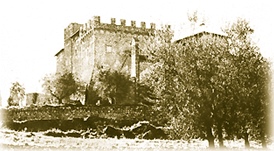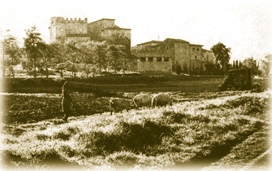
The history of Castel Pietraio begin with a series of struggles and occupations, fought in order to conquer the territory and the castle itself. At the end of the 10th century Strove and Staggia were under the rule of the Countess Ava Lambardi, descending from a noble Longobard family , whose sarcophagus is still on view in the right aisle of the abbey in Abbadia a Isola. The countess Ava and her husband Ildebrando had two sons: Tegrimo who married Sindrada and Berizio who founded Poggio Berizio, now Poggibonsi. In the 12th sentury the Castle was under the rule of the Soarzi. In the 13th century it belonged to Ginibaldo Saracini, Sapia Salvani's husband. She was the daughter of a noble and powerful Sienese family and she was also quoted in Dante Alighieri's Purgatory. In the 15th century it was under the rule of the Capacci, a noble Sienese family coming from Monteagutolo del Bosco, who chose as their own coat of arms a boar's head, carved as ornament on the stones of the floors and of the portals of the castle, and which is still in part visible. The most ancient part of Castel Pietraio is its high tower with its particular Guelph battlement. The next buildings were built later (from 1300 to 1500) and now they form the present quadrangular plan of the complex with the inside cloister, where a well for the collection of the rainwater provided for the water supply of that time; and the outside stone staircase which connected the tower to the most recent buildings. |
The construction of the church dedicated to the Saints Peter and Paul is of the same period. The buildings of the little village completing Castel Pietraio date from 1700.
Baron Massimo Neri Del Nero father of the current owner of Castel Pietraio carried out the restoration of Castel Pietraio and its village, restoring it to its ancient splendor and to that simple austerity that represents the dignity of the old manor-house. He adapted the rooms to the present needs but he always respected the architectural and decorative elements and characteristics, in order to get a deeper penetration of historical, stylistic and landscape elements and to respect, from an ecoenvironmental point of view, the traditions and the places. The olive-trees and the vineyards have been and are still being replaced in order to get a better and better quality. The shortage of factories, the typical traditional Tuscan cultivations such as olive-trees, vines, wheat and sunflowers, the woods of the Park in the Sienese Montagnola, make this Tuscan area a natural oasis. The town of Monteriggioni has just gained the “Orange Flag” that is an important acknowledgment, it guarantee the quality of a land where surrounding, territory, cultural traditions, and natural resources are respected.
 |


